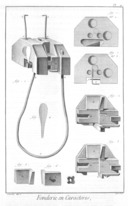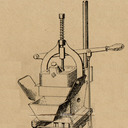These Notebooks conern all topics related directly to the making of type in traditional and lever hand molds.
This section will also include material on those few auxiliary tools which were unique to hand casting (e.g., the ladle). But most of the tools of the hand caster also found a place in machine casting (e.g., alignment gauges). For these, see ../ Noncomposing Typecasters.
For contrivances used by printers for emergency or makeshift casting of types, some of which could/can be held in the hand, see ../ Making Printing Matrices & Types -> Makeshift Typecasting.
After 550 years, the literature on the hand mold and hand casting is still relatively scarce and often difficult to access. This will change with a forthcoming work by Stan Nelson, unquestionably the world's leading authority on, and maker of, hand molds. In the meantime, his 1985 paper in Visible Language on "Mould Making, Matrix Fitting, and Hand Casting" (reprinted, with his kind permission, in the "Literature" section, below) remains the best source of practical information on hand molds for the constructor.

The Literature of the Hand Mold
And hand casting procedures. With illustrations when possible.

Tools Unique to Hand Casting
[NOT DONE] A few of the tools of hand casting are unique to it: the ladle, the stand-alone melting pot. These are covered here.
However, many of the tools used in hand casting are also used in machine casting: the dressing file, the type alignment gauge, etc. Also, much of the auxiliary equipment of hand casting remained unchanged in early machine casting: stones for rubbing type, the dressing bench, etc. These are (or will be) covered in ../ Noncomposing Typecasters.

The Force Pump
Hand casting using a pump for pressure dates to 1833 or 1834, and was necessary for the casting of the early 19th century ornamental types. The force pump became an integral part of Bruce's pivotal type caster and all subsequent type casting machines. It continued in use with hand casting for the trial castings used in matrix justification, and so became known as the "justifier's force pump."

Topics in Hand Molds and Hand Casting
Hardened steel in hand molds.
"The Typefounder's Lever Hand Mold as an Engineering Predecessor of the Pivotal Type Caster."

Engineering Drawings of Hand Molds
And related photographs. Also measured drawings (which aren't quite the same as engineering drawings) of a historic lever hand mold.
All portions of this document not noted otherwise are Copyright © 2008, 2011, 2014-2015, 2023 by David M. MacMillan.
Circuitous Root is a Registered Trademark of David M. MacMillan.
This work is licensed under the Creative Commons "Attribution - ShareAlike" license, version 4.0 International. See http://creativecommons.org/licenses/by-sa/4.0/ for its terms.
Presented originally by Circuitous Root®